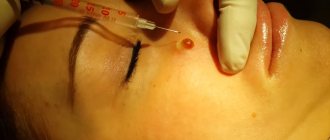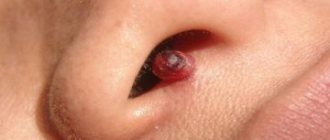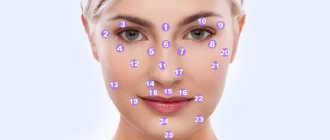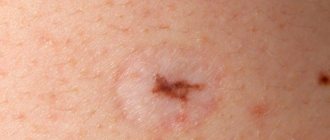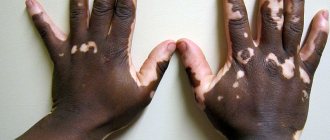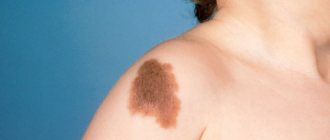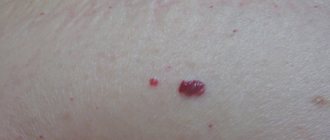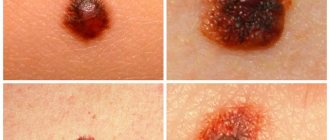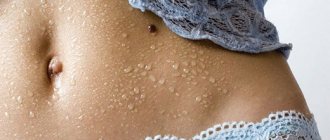What causes moles to appear?
Healthy skin contains a significant number of melanocytes, the function of which is to protect the underlying tissues from ultraviolet radiation. The accumulation of melanin under the influence of sunlight is manifested by a uniform darkening of the skin - tanning. Due to a number of reasons (trauma, burns, hereditary predisposition), melanocytes are able to become activated, and dark spots appear on the body. A type of age spots are ephelides or freckles, characterized by seasonal variability in color.
The bulk of moles are nevi - congenital malformations of the skin. Acquired nevi can appear throughout life; with age, the likelihood of skin tumors increases. Where do moles on the body come from? The main reasons are related to the following conditions:
excessive sun exposure;
- heredity;
- prolonged mechanical irritation of the skin from clothing parts;
- contact with various chemical agents;
- traumatic skin damage;
- age factor;
- inflammation of the skin of any origin, including allergic;
- hormonal dysfunction.
In children
The vast majority of nevi in children are congenital. In newborns, moles are often invisible; they appear over time, gradually acquiring pigmentation. Immediately visible are formations of another, vascular origin - hemangiomas. Pink, red, brown, purple spots fade when lightly pressed, which makes them look different from moles. In children, flat viral warts look like nevi.
During pregnancy
Changes in hormonal levels activate the accumulation of pigment in specific melanocyte cells. A pregnant woman's skin may generally darken, and uneven spotting of the face, arms, and lower abdomen often appears. Moles during pregnancy affect only the epidermal layer of the skin, so they are not convex and cannot be detected to the touch. They can disappear on their own over time or become noticeably pale.
Brown
Pigmented nevi vary in color from grayish to black. More common are brown moles, single or multiple, ranging in size from a point to several centimeters in diameter. The presence of dark skin formations is not a pathology; small structures do not need to be treated. However, some caution is required, especially when there are many moles on the body. Nevi can become malignant, giving rise to the growth of an extremely dangerous melanoma tumor.
The first signs that should cause concern are a change in the shape of the mole, an increase in size. Injured nevi pose a certain danger. Localization of a mole on parts of the body that are subject to pressure or friction from clothing is unfavorable. The large size of the skin formation and the growth of new small structures in the neighborhood are alarming. The listed symptoms require immediate consultation with a dermatologist.
Reds
Vessel-rich red spots or bumps are often hemangioma, a benign vascular tumor. In young children, hemangiomas tend to grow and therefore must be removed. In adults, they are stationary in nature and can disappear spontaneously over time, but the injured formation can bleed for a long time and heal poorly. After removal, red spots occasionally appear again, requiring repeated treatment.
Hanging
Squamous cell papillomas, mistakenly called moles, have a thin stalk. These formations can grow, gradually increasing in size. The color often matches the skin or is slightly darker. Papillomas often come off due to external mechanical force or bending of the leg. Removal is indicated in cases where the formation causes physical or aesthetic discomfort. It is better to get rid of papilloma in a location that contributes to frequent injuries (for example, on the neck in the collar area).
How to remove a pigmented spot on the leg
If you decide to remove a mole on your leg or finger, contact only a medical specialist. A visit to a beauty salon for this purpose is undesirable - the matter is very serious. And doing anything based on outside advice is also extremely undesirable.
Make an appointment with a dermatologist. After examining the mole, he will refer you to the right doctor. The surgeon himself will decide which way is wiser to remove the problematic nevus.
It is recommended to remove moles on the legs using the following methods:
- Laser surgery. It has its advantages - it is painless, bloodless, fast, there are guaranteed to be no relapses, and there will be no traces of the operation. But it is impossible to remove a pigmented spot or large mole on a finger or foot with a laser. Also, this procedure cannot be performed for malignant melanoma.
- Excision with a scalpel. The operation takes about an hour and is performed under local anesthesia. The nevus and some healthy skin are removed and sent for histological analysis. The wound is sutured with a cosmetic suture. A very effective method, but after such an operation a scar may remain.
Let your surgeon choose the treatment method. The main thing is to always take care of your skin, visit a dermatologist at least once every six months, follow his advice. This will help maintain your beautiful appearance and health for many years.
The main reasons for the appearance
The reasons why new moles appear will be different for each person. Researchers say the main trigger factors are heredity, excessive exposure to sunlight, and skin damage. The mechanism of nevus development is the same in all cases: activation and proliferation of melanocytes, accumulation of pigment in them. Based on the depth of location of the skin formation, epidermal, intradermal, and mixed nevi are distinguished.
Heredity
There is an assumption that most moles are genetically programmed; other factors only accelerate their appearance. The development of nevi is based on impaired migration of melanocytes during intrauterine development. Accumulations of these cells determine the likelihood and possibility of the appearance of age spots. Hereditary predisposition is better observed in individuals who have many moles on their body.
What to do if many moles appear on the body
People who have many moles on their body should adhere to the following rules:
- monitor the condition of moles;
- wear loose clothing made from natural fabrics;
- use soft washcloths while taking baths;
- limit time spent in direct sunlight;
- use sunscreen;
- protect moles from damage.
If moles are located in places where they can be accidentally injured (on the scalp, under the arms, on the back, under the breasts, on the soles or palms), you need to contact a qualified specialist who will assess the risk and determine how to remove the tumors.
Causes of appearance and possible dangers
Moles on a child’s body are formed from melanocyte cells. All people have them, and age does not matter. They are localized between the layers of the epidermis.
Pigment cells in a child's body are normal.
The photographs clearly demonstrate what moles on the body look like. They are small in size, their color is brown, and they are imperceptible to the touch.
If such moles on the child’s body are not in single quantities, then this still should not bother you.
If moles change, this may indicate their degeneration.
Moles can appear suddenly or disappear.
If a pale spot is observed in this place, then you should also go to the doctor . This may be a signal for the development of cancer.
What does the appearance of new moles indicate?
Throughout life, the number of moles may change. They can disappear or be added, change their shape and size. It happens that a person with clear skin, under the influence of some factors, develops a new growth.
If there are a lot of moles on the body, but they do not hurt, do not itch, do not bleed, and are not in places prone to injury, then there is no particular cause for concern.
The risk of cancer is higher, the larger the area occupied by the mole.
When should you expect moles to appear?
The cells responsible for pigment in the body begin to form in the mother’s stomach. Scientists say that moles can appear even during birth, but this is very rare.
Most often, a child begins to notice spots around the age of 4..
If moles began to actively appear during the transition period, then the reason for this is hormonal changes. When a person is 30 years old, moles cover his body in large quantities. Further, they slow down their appearance.
Spot on leg. What should I do?
The appearance of such a formation on the leg is the most common, natural process. It can neither be predicted nor prevented. Both congenital formation and acquired during life. If, for example, a mole appears on your toe, this should not be a reason for fear and panic. You shouldn’t be particularly surprised that a mole appeared at 25 or 40 years old. To find out for sure what kind of formation this is, only consult a doctor. Under no circumstances should you try to remove a mole or spot that appears on your leg yourself.
If the nevus is located on the foot, toes, convex or on a “pedicle”, it can create big problems. Starting from disruption of a beautiful gait and selection of shoes, to the worst - malignant formation. Particular attention should be paid when a mole on a leg or finger, especially a red one, begins to:
- condense;
- a white or red halo appeared around her;
- get sick;
- itching, burning sensation;
- inflamed and swollen;
- the pigmented spot began to grow;
- change your color;
- bleed.
Moles on the feet also require increased attention and careful treatment. They can be easily, sometimes unnoticed, injured. And this, sometimes, is fraught with the formation of a cancerous tumor. In such cases, it is worth thinking about removing such nevi.
Should we sound the alarm?
Any moles on a baby are classified according to the following criteria:
They have clear contours and a very dark color (black, brown, purple). The growths are located above the skin. If you press on them, no pain is felt. They can be up to 1 cm in size and have no hair. Sometimes they can grow up to 5 cm. The danger is possible malignancy.
- Intradermal moles
These are ordinary moles. They can be small or large. Moreover, such moles can also have different colors: flesh-colored, brown. There are children who have an intradermal nevus that has a characteristic stalk.
- Complex or mixed form
It is considered a transitional type between the first two. The neoplasm is dense, its shape is spherical, its color is dark, it can be either brown or red. Diameter - 1 cm. They can rarely degenerate into oncology, but they need to be observed. This species also has hairs on the surface.
- Congenital nevi
They are far from uncommon. Doctors explain their appearance by a violation of the mechanism of transformation of cells that were originally the skin of the embryo into melanin. Such moles cannot but be noticed already in the maternity hospital. Degeneration depends on their position relative to the epidermal layers.
Very large moles are rare for children. As a rule, moles are small and grow with the child’s body. As they grow older, their sizes stabilize.
But if you still suspect something is wrong, then to dispel doubts, contact a competent specialist.
What do signs promise if there are a lot of moles - the color and size of the marks
The smaller the marks, the greater luck awaits you. Many small dark marks are a sign of a real darling of fate. As mentioned above, people who expect happiness and wealth in the future have such signs on their bodies; they are lucky in literally anything they do. If this feature was inherited, this indicates that the entire clan is marked by higher powers. Perhaps, through generations, its representatives pass on unique knowledge and abilities.
In addition, owners of many small dark moles endure difficulties and are able to make decisions. Their personal qualities allow them to live a rich and interesting life. The life path of such people is rarely typical. They have developed intuition almost from birth. It helps to avoid dangers and bad decisions.
Why can there be many red moles? These are the signs of Jupiter. They mean that it is the planet Jupiter that has a special influence on your destiny and character. She gives power and wealth. Jupiter's marks may suddenly appear and disappear. If red dots have recently appeared on your body, this means that you will soon have the opportunity to take a leadership position or make a profitable investment, get a job that guarantees a rise up the career ladder, or achieve success through other methods.
A person who has black moles all over his body has a strong character. These marks are a warning from fate, which is such that there will definitely be obstacles on your path. However, Fortune generously rewards people marked with many moles if they pass its tests with dignity. There is also information about the character of such a person - he is overly trusting and quick-tempered. Usually he is distinguished by practicality and the predominance of reason over feelings, but in love he is ready for serious self-sacrifice.
Video consultation with a pediatrician
Watch the video for a detailed consultation with Dr. Komarovsky about moles, warts, molluscum contegium and other skin problems for children. Parents, most importantly, don’t panic!
When do children get moles? Most often, dark spots on the skin form some time after birth. This is influenced by many external and internal factors. Parents need to understand this issue well in order to promptly identify possible violations.
What is a mole
A mole is a congenital or acquired defect in the form of a benign skin formation. The reason for its formation is that melanin begins to accumulate in the upper layers of the epidermis. This pigment is responsible for the color of skin and hair. Over time, the pathological cells themselves become melanocytes, producing melanin. The places where they accumulate are called moles.
Formations can have almost any shape and color. They can appear on different parts of the body - on the head, arms, stomach, face. At first, any mole appears as a flat spot, but over time it begins to grow and can become convex.
Classification of moles
Depending on the location, there are the following types of moles:
- Dermal - excessive formation of melanin is observed in the lower dermal layer. They appear as papules or nodules and often appear between the ages of 10 and 30. When located on the body, they can take the form of warts.
- Epidermal - formed in the upper layer of the skin (epidermis). They have a smooth surface and often have hairs growing on them.
- Borderline or mixed - located in the middle zone between the layers. These are small (up to 1 mm) round or oval formations, with clear boundaries, slightly raised above the skin. Their color varies from light to dark brown. Formed on the face, torso, arms, legs.
- Dysplastic (atypical) are the most dangerous neoplasms that are harbingers of melanoma. They can form in adulthood and reach significant sizes. They are localized in the area of the mammary glands (in women), on the buttocks, in the groin area, on the limbs and head.
Typology
The following types of formations may appear in a newborn or older child:
- Borderline - small nodules of dark color and regular shape. Sometimes their diameter reaches several centimeters. They may protrude slightly above the skin, which is quite normal.
- Intradermal. The color of these moles ranges from brownish to red and black. They can be flat or convex. This type of nevi has a roundish shape. Their diameter reaches 10 mm.
- Congenital. Formed during embryonic development.
- Hanging. Most often it forms in the armpits, neck, and groin, where the skin is thin and constantly subject to friction.
Vascular
A separate group of birthmarks includes vascular moles, which have a reddish tint. This is due to the intensive blood supply to the tissues. They are benign formations and may disappear on their own after some time.
Vascular nevi are usually classified as follows:
- Hemangioma. Usually appears 2-3 weeks after the birth of the child. They can also appear later - by 6-12 months. In most cases, by the age of 1.5 years they turn pale, and by 10 years they completely disappear .
- "Stork bite." Most often it appears on the child’s face or back of the head. It looks like a large pink spot.
- Flaming. It is red in color, found on the baby's head and grows over time. Such formation cannot be removed.
What does a mole on the neck mean for men and women?
Moles have always attracted the attention of others; in the old days, such formations were considered the mark of the devil, and the owner was burned at the stake. In modern society, such an event is no longer approved. But nevi continue to be assigned symbolic meaning.
A mole on the right side of a man’s neck indicates a person’s inclination towards leadership. Holders of these marks achieve great success in military service, the army and political activities. On the left, a growth on the neck indicates great willpower. Such a person is able to move mountains to achieve his goals. On the back of the neck, a nevus symbolizes dedication and efficiency; the owner of the mark is used to giving 100% in any task. A new growth in the middle of the throat is a sign of good luck; such a person will always find a way out of even the most confusing and deplorable situation.
In women, a nevus on the left side of the neck is a symbol of fertility, and on the right it speaks of a desire for adventure and adventurism. If it touches the chin on the side or front, the woman has good intuition and even superpowers.
No matter where the mark is located, remember - it cannot prophesy or change fate. The symbolic meaning can amuse or enhance self-esteem. It pays to be prudent. If your education is growing, go to the doctor, and don’t be happy that your finances will soon increase.
Causes
The formation of nevi in a child is caused by the following factors:
- Genetic predisposition. If parents have large or unusual moles, there is a high probability that their children will also have them.
- Hormonal changes in the body . They are the reason why moles begin to grow on a child. This phenomenon develops especially strongly in adolescence, when puberty occurs.
- Active exposure to the sun. Ultraviolet radiation negatively affects the skin of a person of any age. If a small child is outside for a long time in hot weather without appropriate protection (clothing, creams), it is more likely that he will develop many birthmarks.
Not all children have many moles on the face and body. This unpleasant phenomenon can occur for the following reasons:
- Belonging to the female gender. It has been established that nevi appear in girls 5 times more often than in boys.
- Premature birth.
- Having light skin.
Why do moles appear on the body of adults?
Moles, also called nevi, are one of the manifestations of the human papillomavirus. The reasons for the appearance of moles can be different, often they are associated with some changes in the body. However, no matter at what age and for what reasons nevi appear, you should not be afraid of them, but at the same time you should not ignore them either.
Reasons for appearance
Moles are extremely rarely congenital. As a rule, the first neoplasms appear in children aged 6 to 18 months, and then new nevi form throughout life. There is probably not a single adult who does not have these manifestations of the human papillomavirus. The appearance of moles on the face and body is provoked by the papillomavirus, which is present in all people. In addition, depending on the color and nature of the moles, other health problems can be identified that lead to the formation of nevi.
When considering the question of why new moles appear, you need to take into account several basic premises:
- Heredity. This is one of the main reasons. It often happens that family members have nevi of the same shape and size.
- Exposure to ultraviolet radiation on the skin. Photoirradiation, which we receive when we sunbathe under the natural sun or in a solarium, promotes the formation of melanocytes, from which nevi form.
- The appearance of these neoplasms also depends on hormonal levels. If there are any deviations in this area, then new formations on the skin may appear in large numbers.
- Injuries to the skin are also often the reason why moles appear.
- Exposure to X-rays or radio waves. Such factors may be relevant when conducting medical examinations, as well as when working in hazardous industries.
- Age-related changes in the body are another answer to the question of why moles appear on the body.
- The appearance of red moles may be evidence of impaired functioning of blood vessels. They can also appear when there are problems with the pancreas, liver and other organs of the gastrointestinal tract.
- Exposure to chemicals or toxic substances. People involved in the development and testing of medicines or other drugs often notice that such tumors appear in large numbers.
Factors that provoke the formation of new nevi accompany us literally at every step and are constantly present in everyday life. The causes of the appearance of moles cannot be ruled out, but changes in the number and characteristics of these formations can be monitored.
Potential dangers
Thus, the answer to the question of why nevi appear involves many completely different answers. And one should not always sound the alarm if new formations of this nature form on the face and body. For example, the appearance of moles on the face and body often accompanies women during pregnancy or lactation. Other periods of changes in hormonal levels or health conditions can also become an impetus for the appearance of new formations on the skin.
But it also happens that the appearance of new moles cannot be ignored due to their potential danger. Particular attention should be paid to nevi when the following conditions exist:
- If they appear in areas that are easy to injure. This could be the head, neck or back. In these places, moles can be missed and damaged by a comb or clothing.
- If a lot of moles appear in a short period of time. Especially, you need to pay attention to such skin changes if there are no visible reasons for them.
- If moles of irregular shape and uneven color appear on the body or face.
- If existing nevi begin to become denser, increase in size, bleed, cause itching, and also when an areola appears around them.
In such cases, it is advisable to consult a doctor. It will identify the potential danger of skin growths, which will require a blood test and possibly a biopsy of the problematic growths. If necessary, the doctor will prescribe treatment or remove nevi to avoid potential troubles.
Mole removal
Sometimes it is necessary to remove nevi for medical reasons, and sometimes this is due to the aesthetic side of the issue. But regardless of why moles appear, and for what reason there was a desire to get rid of them, modern medicine provides many opportunities to remove skin growths. Most of the methods for getting rid of nevi are safe, do not cause bleeding, and therefore prevent the spread of potentially dangerous microorganisms through the bloodstream.
Laser coagulation is considered the most modern and innovative way to remove moles. This procedure is practically painless and non-traumatic. There will be no scars or redness of the skin at the treatment site.
The next method used to remove moles is treatment of the neoplasm with liquid nitrogen, also called cryodestruction. It also does not involve pain and rehabilitation. Within two to three weeks after removal of the nevus, no traces will remain in its place.
Until recently, the classic method of removing moles was their surgical excision. However, this method is quite painful. In addition, removing moles with a scalpel is associated with the potential danger of re-infection and various complications, which is why it is practically not used today.
Prevention of skin tumors
Knowing why moles appear, you can develop rules for preventing these manifestations of the human papillomavirus:
- One of the important points of protection against nevi is to limit exposure to the sun, and if this cannot be done, then it is necessary to treat the skin with sunscreen.
- It is also important to protect the skin from excessive trauma. In cases where it is not possible to avoid wounds and abrasions, they must be treated with aseptic compounds.
- Do not forget to monitor the health of your internal organs and systems, as malfunctions in their functioning often provoke the appearance of moles on the body.
- When working in hazardous industries, do not neglect safety precautions and means of protection against various chemicals and other toxic substances.
Of course, it is impossible to exclude all factors in the appearance of new moles. However, by following certain rules, you can reduce the risk of a large number of these growths on the skin.
LadyCleo.ru>
Signs of a safe nevus
If a birthmark is detected in a child of any age, you should consult a doctor. He will examine the formation and determine how dangerous it is. If necessary, the doctor may recommend its removal. But if the following signs are present, it is better to simply observe the formation, since it is benign:
- Symmetrical nevus of regular shape with clear edges.
- The color of the formation ranges from flesh-colored to bright red or even black.
- The nevus protrudes only slightly above the surface of the body.
- Nevus growth occurs slowly.
- Formations whose diameter does not exceed 1.5 mm are considered not dangerous. If the nevus is larger, it needs to be monitored more closely. Such a mole is susceptible to injury, which can trigger malignant processes in it.
- If there is hair on the surface of the nevus, this is good. This sign indicates the benign quality of the formation.
Which ones are dangerous?
As a rule, birthmarks do not pose any health hazard. However, if many moles appear on the body, this may well be a manifestation of a number of diseases. You should also pay attention to the following signs:
- A rapid increase in the mark, a change in its color and volume.
- There is some blurring of the boundaries.
- The appearance of inflammatory processes is noted.
- Bleeding appears.
- There are external changes, such as the appearance of cracks, dark spots, and nodules on the mole.
If any of the above symptoms appear, you should immediately contact a specialist for diagnostic procedures.
Diagnostic methods
When a suspicious mole is detected in a child, the doctor uses the following diagnostic procedures to determine its condition:
- Visual inspection. The doctor examines the formation, measures its diameter, evaluates its shape and color.
- Dermatoscopy. Using a special instrument, a dermatologist can examine the mole at multiple magnification. Dermatoscopy allows you to determine the presence of oncology in the early stages.
- Digital dermatoscopy. The latest diagnostic method, during which a skin formation is displayed on the screen, magnified thousands of times.
Methods of disposal
Cryodestruction
Cryodestruction is a method of removing moles under the influence of low temperatures and liquid nitrogen. After this procedure, the moles become crusty and then die off, and healing occurs on the skin. The duration of skin restoration is about a month.
Laser removal
Removing moles with a laser is another very effective way to get rid of them. This procedure lasts very quickly and takes only 5 minutes . The person having the nevus removed will not experience pain due to prior local anesthesia.
The specialist who removes the mole can control the diameter as well as the depth of penetration of the laser. Due to this, the nevus is easily removed and nearby tissues are not damaged. After such a procedure, bleeding will not appear on the human body and scars will not remain. The skin recovers after mole removal within a few weeks.
Radio wave
The radio wave method is another effective way to remove moles. After this procedure, there are no scars left on the legs . Most often, this procedure is used to remove moles that protrude above the surface of the skin.
This method also allows you to take tissue for histological examination to find out whether the mole is malignant. The disadvantage of this method is the ability to remove only small tumors.
Medication
Drug therapy is also used to combat moles. But in such a situation you need to be very careful not to harm your body.
Before using medications to remove moles, you should first consult a specialist . After it resolves, treatment can be carried out. Ointment “Stefalin”, “Superchistotel” in ampoules and other effective preparations are used to remove moles.
Important! Before using medications, be sure to read the instructions.
Treatment options
The only way to get rid of moles is through surgery. Any other impact on education in children is prohibited, as this can trigger malignant processes. Laser is most often used to remove moles.
Indications for the procedure:
- injury to a mole;
- any liquid oozes on the surface of the nevus, blood appears;
- the formation is itchy and flaky;
- the nevus began to grow rapidly or changed its shape or color in a short period of time.
It is wrong to remove moles for aesthetic reasons, since any tissue trauma carries a potential danger.
If there are moles of any shape or size, parents should monitor their child at all times. If alarming symptoms appear, you should consult a doctor to avoid complications.
>
What to do if a nevus is damaged
If a nevus is damaged, it is important to provide first aid at home. If there is bleeding, it should be stopped, then the wound should be treated. The procedure is as follows:
- soak a generous piece of sterile bandage in hydrogen peroxide and apply to the wound. Within a few minutes the bleeding should stop completely;
- To protect against infection, the wound is treated with a strong antiseptic (chlorhexidine). The effect of the drug lasts for a long time. If such a remedy is not available, you can treat the edges of the wound with iodine;
- after treatment, apply a sterile bandage and secure with adhesive tape;
- If there is no bleeding, it is enough to treat the wound with an antiseptic and apply a sterile bandage. It is not necessary to see a doctor;
- if the formation is torn, treat it and secure it carefully with a sterile bandage, avoid touching the injured area, as pain will appear. It is recommended to see a doctor as soon as possible;
- in the case when the mole comes off completely, you need to stop the bleeding and treat the wound with an antiseptic, apply a sterile bandage, place the torn piece in saline solution and go to the doctor to determine the malignant nature of the nevus.
It is advisable to see a doctor to identify the nature of the formation and make a decision on possible removal.
Comments
- megan92 () 2 weeks ago
Has anyone managed to get rid of papillomas in their armpits? They really bother me, especially when you sweat.
- Daria () 2 weeks ago
I have already tried so many things and only after reading this article, I was able to get rid of papillomas in the armpits (and on a very budget). PS But I’m from the city myself and didn’t find it on sale here, so I ordered it online.
- megan92 () 13 days ago
Daria, post a link to the article! PS I'm from the city too))
- Daria () 12 days ago
megan92, that’s what I wrote in my first comment) I’ll duplicate it just in case - a link to the article.
- Sonya 10 days ago
Isn't this a scam? Why do they sell on the Internet?
- Yulek26 (Tver) 10 days ago
Sonya, what country do you live in? They sell it on the Internet because stores and pharmacies charge outrageous markups. In addition, payment is only after receipt, that is, they first looked, checked and only then paid. And now everything is sold on the Internet - from clothes to TVs and furniture.
- Editor's response 10 days ago
Sonya, hello. This drug for the treatment of papillomavirus infection is indeed not sold through pharmacy chains and retail stores in order to avoid inflated prices. As of today, you can only order on the official website. Be healthy!
- Sonya 10 days ago
I apologize, I didn’t notice the information about cash on delivery at first. Then everything is fine if payment is made upon receipt.
- Margo (Ulyanovsk) 8 days ago
Has anyone tried traditional methods to get rid of warts and papillomas?
- Andrey A week ago
I tried to burn off a wart on my head with vinegar. The wart really went away, only in its place there was such a burn that my finger hurt for another month. And the most annoying thing is that after a month and a half, two more warts popped up nearby ((
- Ekaterina A week ago
I tried to burn out the papilloma with celandine, but it didn’t help, it just turned black and became so scary (((
- Maria 5 days ago
I recently watched a program on Channel One, they also talked about this PAPIFEX. Many doctors recommended for treatment. I ordered it, I use it, and indeed, the papillomas are dissolving one by one, there are only 2 left, the most tenacious ones.
- Elena (dermatologist) 6 days ago
Maria, soon these two will disappear too!
- Alexandra (Syktyvkar) 5 days ago
A good product, completely worth the price. I have never seen any analogues.
- Maxim Today
Has anyone tried to reduce papillomas with liquid nitrogen?
- Tatyana (Ekaterinburg) Today
Yeah, you burn one, after a month three more grow ((I don’t recommend liquid nitrogen, although hospitals often use it
- Elena (dermatologist) 6 days ago
Tatyana, liquid nitrogen is a thing of the past, now PAPIFEX is used in full and there is no need to go to the doctors!
- Mikhail (Moscow) Today
PAPIFEX also helped (I ordered it according to the advice above), it should work, try it
- Vika (Ekaterinburg) Today
That's great! I need to order, otherwise I’m already tormented with these warts! After all, a woman always wants to be beautiful!
- Kristina (Minsk) Today
I had papillomas removed with a laser, quickly and without pain. But it's damn expensive.
Removal methods
There are several removal methods. Each of them is effective, but the doctor must choose the appropriate one after diagnosis. You can get rid of moles in the following ways:
| Instrumental |
|
| Medication (drugs) |
|
| Home treatment |
|
The choice of treatment method is based on the location of the mole, its color, size and individual characteristics of the patient’s body.
Under no circumstances should you tear off a mole! You can provoke its degeneration into cancer.
If you notice that the tumor is bleeding or injured, treat the affected area with peroxide and consult a dermatologist.
